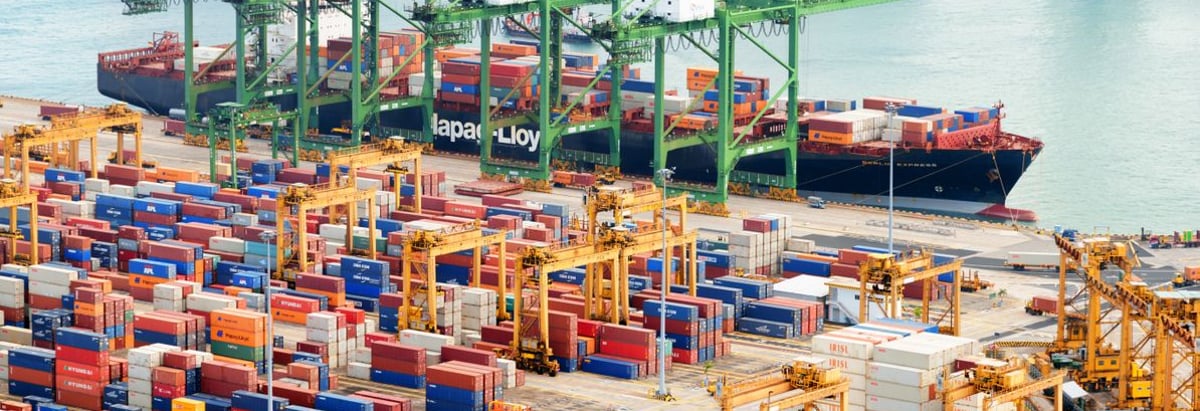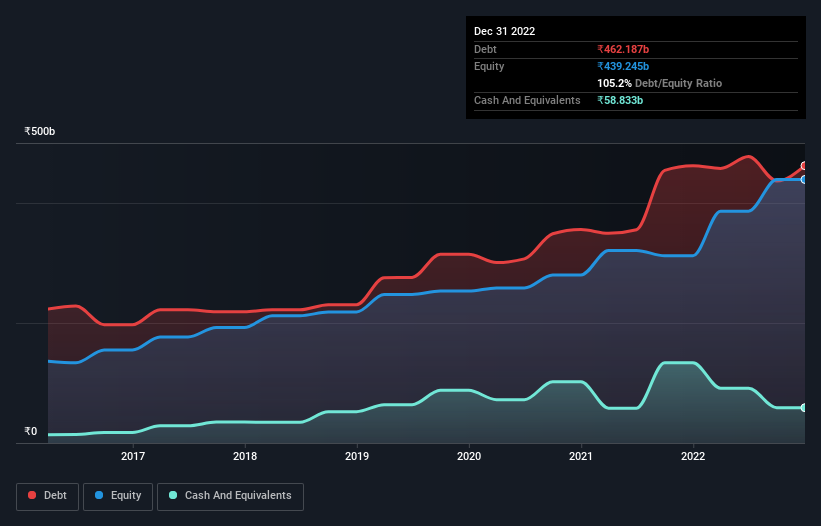- India
- /
- Infrastructure
- /
- NSEI:ADANIPORTS
We Think Adani Ports and Special Economic Zone (NSE:ADANIPORTS) Can Stay On Top Of Its Debt

The external fund manager backed by Berkshire Hathaway's Charlie Munger, Li Lu, makes no bones about it when he says 'The biggest investment risk is not the volatility of prices, but whether you will suffer a permanent loss of capital.' When we think about how risky a company is, we always like to look at its use of debt, since debt overload can lead to ruin. Importantly, Adani Ports and Special Economic Zone Limited (NSE:ADANIPORTS) does carry debt. But the real question is whether this debt is making the company risky.
When Is Debt A Problem?
Generally speaking, debt only becomes a real problem when a company can't easily pay it off, either by raising capital or with its own cash flow. Ultimately, if the company can't fulfill its legal obligations to repay debt, shareholders could walk away with nothing. However, a more common (but still painful) scenario is that it has to raise new equity capital at a low price, thus permanently diluting shareholders. By replacing dilution, though, debt can be an extremely good tool for businesses that need capital to invest in growth at high rates of return. When we think about a company's use of debt, we first look at cash and debt together.
Check out our latest analysis for Adani Ports and Special Economic Zone
How Much Debt Does Adani Ports and Special Economic Zone Carry?
The chart below, which you can click on for greater detail, shows that Adani Ports and Special Economic Zone had ₹462.2b in debt in September 2022; about the same as the year before. However, because it has a cash reserve of ₹58.8b, its net debt is less, at about ₹403.4b.

A Look At Adani Ports and Special Economic Zone's Liabilities
The latest balance sheet data shows that Adani Ports and Special Economic Zone had liabilities of ₹90.2b due within a year, and liabilities of ₹469.1b falling due after that. Offsetting this, it had ₹58.8b in cash and ₹45.8b in receivables that were due within 12 months. So it has liabilities totalling ₹454.6b more than its cash and near-term receivables, combined.
This deficit isn't so bad because Adani Ports and Special Economic Zone is worth a massive ₹1.41t, and thus could probably raise enough capital to shore up its balance sheet, if the need arose. But it's clear that we should definitely closely examine whether it can manage its debt without dilution.
We use two main ratios to inform us about debt levels relative to earnings. The first is net debt divided by earnings before interest, tax, depreciation, and amortization (EBITDA), while the second is how many times its earnings before interest and tax (EBIT) covers its interest expense (or its interest cover, for short). Thus we consider debt relative to earnings both with and without depreciation and amortization expenses.
Adani Ports and Special Economic Zone's net debt is 3.5 times its EBITDA, which is a significant but still reasonable amount of leverage. But its EBIT was about 15.1 times its interest expense, implying the company isn't really paying a high cost to maintain that level of debt. Even were the low cost to prove unsustainable, that is a good sign. We note that Adani Ports and Special Economic Zone grew its EBIT by 23% in the last year, and that should make it easier to pay down debt, going forward. When analysing debt levels, the balance sheet is the obvious place to start. But it is future earnings, more than anything, that will determine Adani Ports and Special Economic Zone's ability to maintain a healthy balance sheet going forward. So if you want to see what the professionals think, you might find this free report on analyst profit forecasts to be interesting.
Finally, a business needs free cash flow to pay off debt; accounting profits just don't cut it. So it's worth checking how much of that EBIT is backed by free cash flow. Over the most recent three years, Adani Ports and Special Economic Zone recorded free cash flow worth 74% of its EBIT, which is around normal, given free cash flow excludes interest and tax. This free cash flow puts the company in a good position to pay down debt, when appropriate.
Our View
Happily, Adani Ports and Special Economic Zone's impressive interest cover implies it has the upper hand on its debt. But, on a more sombre note, we are a little concerned by its net debt to EBITDA. We would also note that Infrastructure industry companies like Adani Ports and Special Economic Zone commonly do use debt without problems. Looking at the bigger picture, we think Adani Ports and Special Economic Zone's use of debt seems quite reasonable and we're not concerned about it. After all, sensible leverage can boost returns on equity. The balance sheet is clearly the area to focus on when you are analysing debt. However, not all investment risk resides within the balance sheet - far from it. For example Adani Ports and Special Economic Zone has 4 warning signs (and 1 which is potentially serious) we think you should know about.
At the end of the day, it's often better to focus on companies that are free from net debt. You can access our special list of such companies (all with a track record of profit growth). It's free.
If you're looking to trade Adani Ports and Special Economic Zone, open an account with the lowest-cost platform trusted by professionals, Interactive Brokers.
With clients in over 200 countries and territories, and access to 160 markets, IBKR lets you trade stocks, options, futures, forex, bonds and funds from a single integrated account.
Enjoy no hidden fees, no account minimums, and FX conversion rates as low as 0.03%, far better than what most brokers offer.
Sponsored ContentNew: Manage All Your Stock Portfolios in One Place
We've created the ultimate portfolio companion for stock investors, and it's free.
• Connect an unlimited number of Portfolios and see your total in one currency
• Be alerted to new Warning Signs or Risks via email or mobile
• Track the Fair Value of your stocks
Have feedback on this article? Concerned about the content? Get in touch with us directly. Alternatively, email editorial-team (at) simplywallst.com.
This article by Simply Wall St is general in nature. We provide commentary based on historical data and analyst forecasts only using an unbiased methodology and our articles are not intended to be financial advice. It does not constitute a recommendation to buy or sell any stock, and does not take account of your objectives, or your financial situation. We aim to bring you long-term focused analysis driven by fundamental data. Note that our analysis may not factor in the latest price-sensitive company announcements or qualitative material. Simply Wall St has no position in any stocks mentioned.
About NSEI:ADANIPORTS
Adani Ports and Special Economic Zone
Operates and maintains port infrastructure facilities in India.
Solid track record average dividend payer.
Similar Companies
Market Insights
Community Narratives




